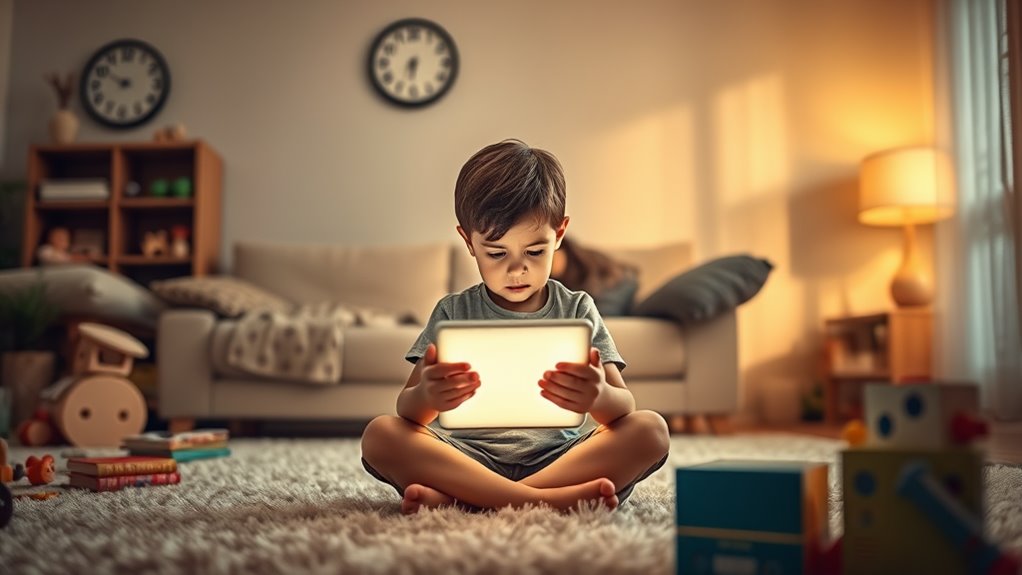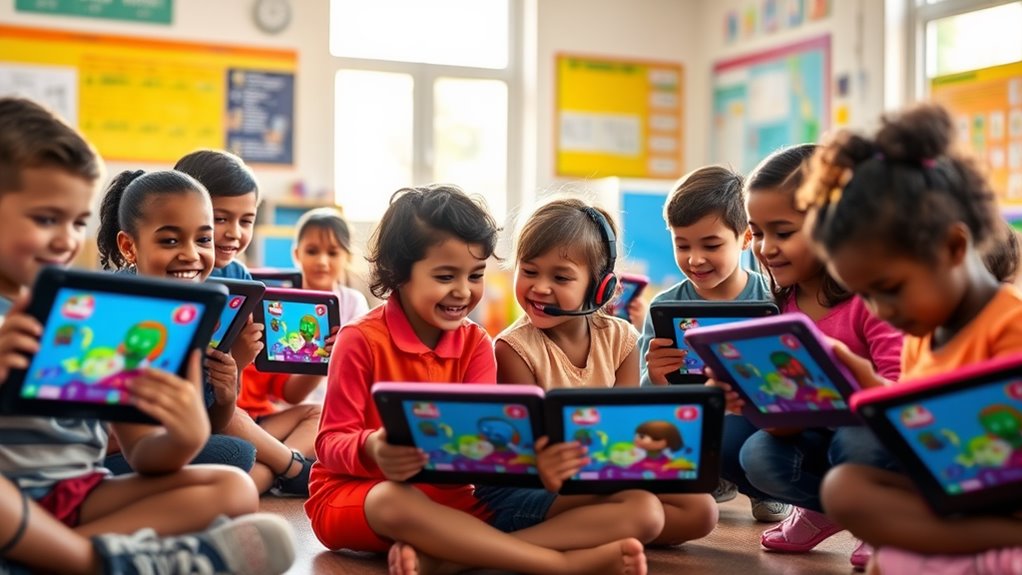The Truth About Screen Time- What Every Parent Needs to Know
Screen time is a part of your child’s daily routine, but understanding its effects is crucial for their development. While quality content can boost creativity and learning, excessive use can lead to attention issues and distorted self-images. It’s important to set boundaries, like tech-free zones, and offer a balance with physical activities. The American Academy of Pediatrics suggests specific screen time limits based on age, emphasizing co-viewing and discussions about digital content. By modeling healthy habits and scheduling family activities, you can help your child navigate their screen use effectively. There’s so much more to explore on this topic.
Key Takeaways
-
Screen time encompasses all digital media use, and quality of content significantly impacts child development and learning outcomes.
-
The AAP recommends avoiding screen time for children under 18 months, with limited high-quality content for toddlers and preschoolers.
-
Excessive screen time can lead to attention issues, hinder emotional regulation, and distort self-image, necessitating careful monitoring and balance.
-
Establishing clear screen time boundaries and tech-free zones promotes family interaction and helps children develop healthy habits.
-
Encouraging outdoor play and real-life activities is essential for physical health and social skills, fostering a well-rounded lifestyle.
Understanding Screen Time
Understanding screen time is crucial for parents who want to balance their family’s digital consumption. It’s not just about limiting hours; it’s about recognizing the quality of content your kids engage with. Screen time encompasses everything from educational apps to social media, and how you guide your children through these platforms can shape their digital literacy.
You might think that all screen time is equal, but that’s far from true. For instance, interactive learning games can enhance problem-solving skills, while passive viewing may not offer the same benefits. It’s essential to help your kids discern between productive and unproductive screen time.
Encourage them to explore educational resources, and engage in discussions about what they watch or play. This creates an environment where they can develop critical thinking skills related to digital content.
Moreover, setting boundaries is key. Choose specific times for screen use and have tech-free zones in your home to promote balance.
Effects on Child Development
Screen time can significantly impact a child’s development in various ways, both positive and negative. When kids engage with educational content, it can enhance their cognitive development. Interactive apps and games can improve problem-solving skills, boost creativity, and even teach new concepts.
However, excessive screen time can hinder this growth, leading to difficulties in attention and learning.
On the emotional side, screen time can affect children’s emotional regulation. When they spend hours absorbed in screens, they might struggle to manage their emotions effectively. They could become easily frustrated or overwhelmed, especially during gameplay.
Additionally, if they’re constantly exposed to unrealistic portrayals of life online, it can distort their expectations and self-image, leading to anxiety or low self-esteem.
It’s crucial to monitor what your child interacts with and how long they spend on screens. Balancing screen time with physical activities and face-to-face interactions can promote healthier emotional regulation and cognitive skills.
Recommended Screen Time Guidelines
Finding the right balance for screen time can be challenging for parents, but following established guidelines can help. The American Academy of Pediatrics (AAP) provides age recommendations that serve as a useful starting point.
For children under 18 months, it’s best to avoid screen time, except for video chatting. For toddlers aged 18 to 24 months, you can introduce high-quality programming, but watch it with them to help them understand what they see.
For preschoolers aged 2 to 5 years, limit screen time to one hour per day of high-quality content, again co-viewing to facilitate discussion and comprehension.
As children grow into school age, the recommendations suggest maintaining consistent limits, while ensuring that screen time doesn’t interfere with sleep, physical activity, and other essential behaviors.
For teens, it can be a bit more flexible, but you should still encourage them to balance screen time with other activities.
Balancing Digital and Real-Life Activities
Balancing digital and real-life activities is vital for your child’s overall well-being. Too much screen time can lead to a sedentary lifestyle, which isn’t ideal for their physical and mental health.
Encourage outdoor play by setting aside specific times for activities like biking, hiking, or playing sports. These experiences not only promote fitness but also give your child a chance to explore nature and develop social skills.
Incorporating family activities into your routine can help create a healthy balance. Plan regular family outings, such as visits to the park, game nights, or cooking together. These moments strengthen bonds and provide opportunities for your child to engage with loved ones without screens.
Consider creating a family schedule that designates time for both digital entertainment and real-life interactions. This structure helps your child understand the importance of moderation.
Lastly, be a role model; if you prioritize outdoor play and family activities, your child is more likely to follow suit. By finding that balance, you’ll help your child develop a well-rounded lifestyle that values both digital and real-world experiences.
Tips for Managing Screen Time
In today’s digital age, managing screen time effectively is crucial for maintaining a healthy lifestyle for you and your child. Start by establishing clear screen time boundaries. Set specific limits on daily usage, and ensure everyone in the family understands these rules. This helps create a sense of accountability and encourages your child to engage in other activities.
Next, make family media a priority. Designate tech-free zones, like the dinner table or bedrooms, to foster family interactions without screens. Use this time to connect, share stories, and discuss your day. You can also schedule regular family activities that don’t involve screens, like board games or outdoor adventures, reinforcing the importance of real-life interactions.
Don’t forget to model healthy screen habits yourself. When your child sees you engaging in non-digital activities, they’re more likely to follow suit.
Lastly, be open to discussing the reasons behind your screen time boundaries. Teaching your child about the importance of balance and moderation will empower them to make better choices, even when they’re not under your supervision.
Encouraging Healthy Tech Habits
Establishing screen time boundaries is just the first step in fostering a healthy relationship with technology. To truly encourage healthy tech habits, you need to be a role model. Your kids are watching how you engage with screens, so demonstrate balance and mindful usage.
It’s essential to create an environment where tech is a reward, not a default. Instead of allowing screens during meal times or family activities, reserve tech time for special rewards.
Here are some ways to nurture this balance:
- Engage in screen-free family activities**** that promote connection and creativity.
- Set tech-free zones in your home, like the dining room or bedrooms.
- Encourage outdoor play and physical activities to help reduce screen dependency.
- Discuss the importance of face-to-face interactions**** and emotional connections.
Frequently Asked Questions
Can Screen Time Affect Sleep Quality in Children?
Yes, screen time can affect your child’s sleep quality. The blue light emitted by devices can interfere with bedtime routines, making it harder for them to fall asleep. Consider limiting screen use before bedtime for better rest.
What Are the Signs of Screen Addiction in Kids?
Imagine a flower wilting without sunlight. If you notice behavioral changes like irritability or emotional withdrawal in your child, it might signal screen addiction. Pay attention to these signs before they become harder to manage.
How Do Different Types of Content Impact Children?
Different types of content can significantly impact your child. Educational content boosts learning, while violent media may increase aggression. Interactive games foster engagement, but passive viewing can lead to emotional detachment. Always ensure age-appropriate content and screen time balance.
Is There a Specific Age When Screen Time Becomes Harmful?
There’s no magic age when screen time turns harmful, but following screen time guidelines is crucial. It’s vital to consider developmental milestones; excessive exposure can hinder growth, so moderation is key at every age.
How Can Parents Model Healthy Screen Habits for Their Kids?
To model healthy screen habits, you should limit your own screen time, engage in offline activities, and encourage discussions about digital content. Your parental guidance plays a crucial role in shaping your child’s relationship with screen time.





